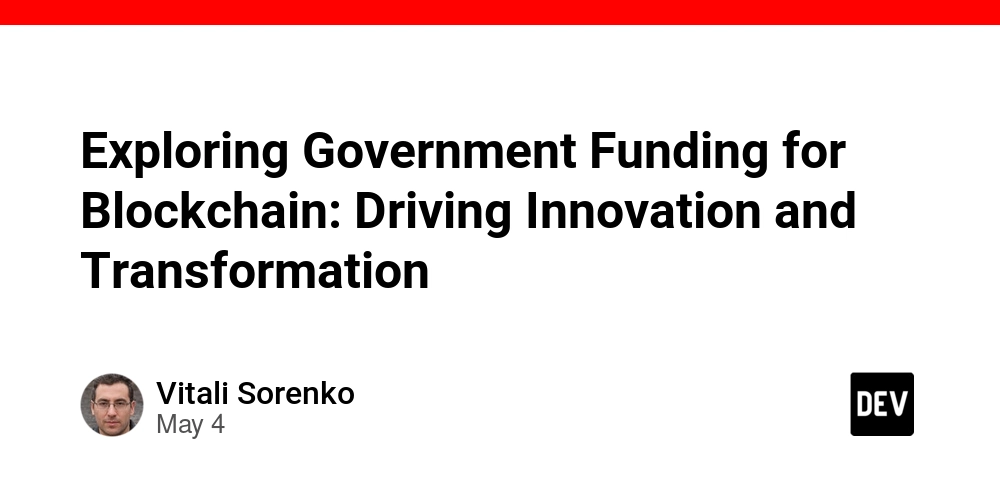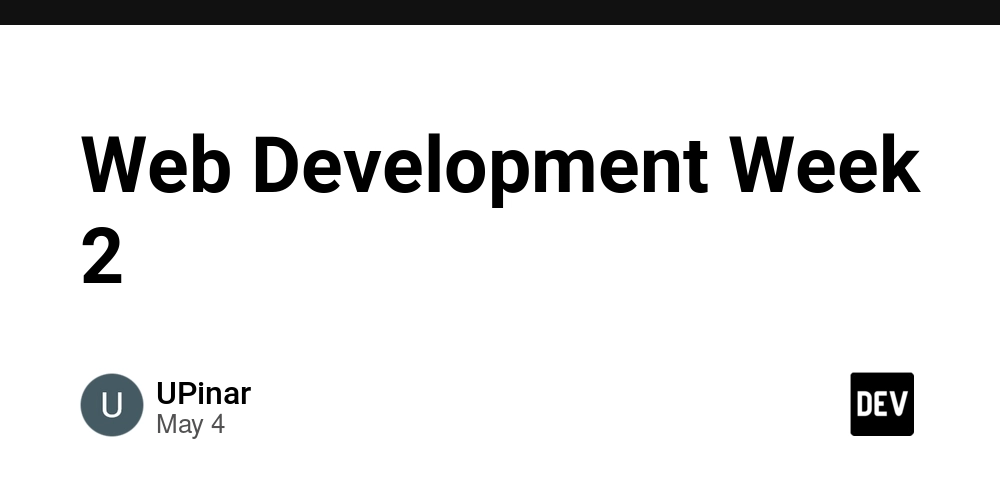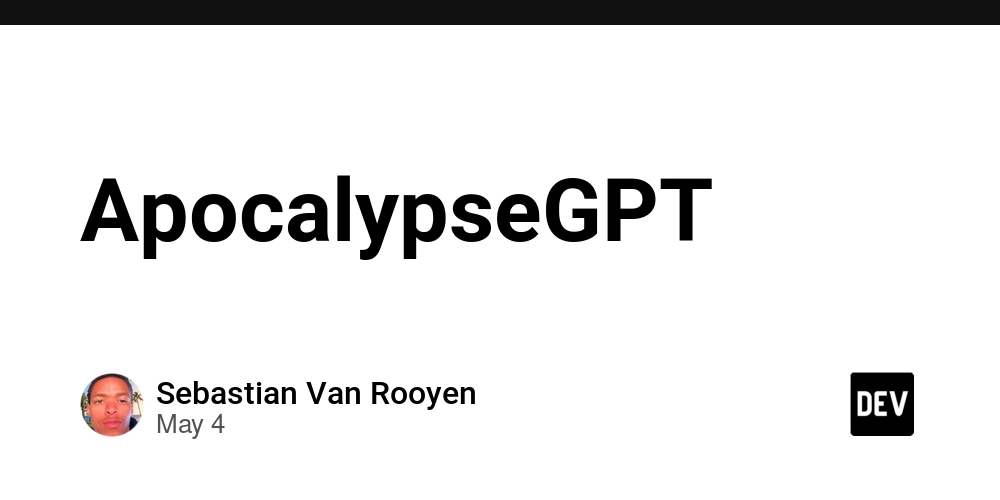Exploring Government Funding for Blockchain: Driving Innovation and Transformation
Abstract Government funding for blockchain has emerged as a transformative catalyst across multiple sectors. In this post, we explore the history, key initiatives, technical core concepts, applications, challenges, and future outlook of government-funded blockchain projects. We highlight examples such as the European Blockchain Partnership, NIST's research in the US, China's BSN, Estonia’s e-government strategies, and Australia’s Blockchain Roadmap, and incorporate additional insights from related sources. This comprehensive analysis is supported by tables, bullet lists, and curated links from authoritative sources and Dev.to posts, ensuring technical depth with accessible language for both human readers and search engines. Introduction Governments worldwide are allocating funding for blockchain initiatives, recognising its potential to revolutionize public services, secure digital infrastructure, and stimulate economic growth. Blockchain technology, originally designed as the backbone of cryptocurrencies, has evolved into a versatile tool with applications ranging from identity management to decentralized finance. With multi-billion-dollar investments and the introduction of public-private partnerships, blockchain has the strategic ability to drive innovation in public governance and cybersecurity. In this post, we delve into the reasons behind government funding for blockchain projects. We will cover historical context, core technical concepts, real-world use cases, and the hurdles that need to be overcome. Whether you are a developer, policy maker, or technology enthusiast, the insights provided here offer an accessible overview of how government funding is shaping the future of blockchain. Background and Context A Brief History of Blockchain Blockchain started as a decentralized ledger technology in 2008, introduced as part of Bitcoin. However, its utility has rapidly grown to include: Transparency in transactions Decentralized data management Enhanced security features Governments recognized early on that these features could support secure public records, supply chain integrity, and efficient cross-border transactions. Governmental Interest: The Ecosystem Governmental bodies around the world are pursuing blockchain for several reasons: Digital Transformation: Modernization of public services and quest for improved data integrity. Economic Growth: Stimulating startup ecosystems, digital innovation, and financial inclusion. Cybersecurity: Minimizing breaches and ensuring resilience in a rapidly digitizing world. Key initiatives in the global blockchain funding landscape include: European Blockchain Partnership (EBP) United States National Institute of Standards and Technology (NIST) China's Blockchain Service Network (BSN) Estonia's E-Government Initiatives Australia's Blockchain Roadmap Core Concepts and Features Government funding for blockchain revolves around several key concepts and features that drive innovation: Blockchain Fundamentals Decentralization: Unlike traditional databases, no central authority controls blockchain. Immutability: Transactions are recorded permanently and cannot be changed without consensus. Transparency: Every transaction is visible to participating nodes, bolstering trust in public processes. Government-Funded Initiatives: A Quick Overview Below is a table that summarizes some of the landmark initiatives: Initiative Country/Region Core Focus Key Features European Blockchain Partnership (EBP) European Union Cross-border public service improvement Interoperability, regulatory framework National Institute of Standards and Technology (NIST) United States Enhancing system integrity & resilience Research-driven standards, cybersecurity focus Blockchain Service Network (BSN) China Expanding accessibility and affordability Public infrastructure, cost reduction E-Government Initiatives Estonia Public service transformation Digital identity & secure transactions Blockchain Roadmap Australia Application in agriculture & taxation Supply chain transparency, regulatory integration Key Features of Government Blockchain Projects Interoperability: Facilitating seamless interaction between different blockchain networks ensures government systems can communicate with global digital ecosystems. Scalability: Addressing challenges of scaling blockchain solutions to support millions of transactions per second is crucial for public applications. Policy and Regulation: Tailored legal frameworks guide blockchain applications while preventing misuse and ensuring data protection. For more on technical challenges and blockchain scalability, see Blockchain Scalability Solutions. Applications and Use Cases Government-funded blockchain projects provide compelling use cases that have a practical impact on public administra

Abstract
Government funding for blockchain has emerged as a transformative catalyst across multiple sectors. In this post, we explore the history, key initiatives, technical core concepts, applications, challenges, and future outlook of government-funded blockchain projects. We highlight examples such as the European Blockchain Partnership, NIST's research in the US, China's BSN, Estonia’s e-government strategies, and Australia’s Blockchain Roadmap, and incorporate additional insights from related sources. This comprehensive analysis is supported by tables, bullet lists, and curated links from authoritative sources and Dev.to posts, ensuring technical depth with accessible language for both human readers and search engines.
Introduction
Governments worldwide are allocating funding for blockchain initiatives, recognising its potential to revolutionize public services, secure digital infrastructure, and stimulate economic growth. Blockchain technology, originally designed as the backbone of cryptocurrencies, has evolved into a versatile tool with applications ranging from identity management to decentralized finance. With multi-billion-dollar investments and the introduction of public-private partnerships, blockchain has the strategic ability to drive innovation in public governance and cybersecurity.
In this post, we delve into the reasons behind government funding for blockchain projects. We will cover historical context, core technical concepts, real-world use cases, and the hurdles that need to be overcome. Whether you are a developer, policy maker, or technology enthusiast, the insights provided here offer an accessible overview of how government funding is shaping the future of blockchain.
Background and Context
A Brief History of Blockchain
Blockchain started as a decentralized ledger technology in 2008, introduced as part of Bitcoin. However, its utility has rapidly grown to include:
- Transparency in transactions
- Decentralized data management
- Enhanced security features
Governments recognized early on that these features could support secure public records, supply chain integrity, and efficient cross-border transactions.
Governmental Interest: The Ecosystem
Governmental bodies around the world are pursuing blockchain for several reasons:
- Digital Transformation: Modernization of public services and quest for improved data integrity.
- Economic Growth: Stimulating startup ecosystems, digital innovation, and financial inclusion.
- Cybersecurity: Minimizing breaches and ensuring resilience in a rapidly digitizing world.
Key initiatives in the global blockchain funding landscape include:
- European Blockchain Partnership (EBP)
- United States National Institute of Standards and Technology (NIST)
- China's Blockchain Service Network (BSN)
- Estonia's E-Government Initiatives
- Australia's Blockchain Roadmap
Core Concepts and Features
Government funding for blockchain revolves around several key concepts and features that drive innovation:
Blockchain Fundamentals
- Decentralization: Unlike traditional databases, no central authority controls blockchain.
- Immutability: Transactions are recorded permanently and cannot be changed without consensus.
- Transparency: Every transaction is visible to participating nodes, bolstering trust in public processes.
Government-Funded Initiatives: A Quick Overview
Below is a table that summarizes some of the landmark initiatives:
| Initiative | Country/Region | Core Focus | Key Features |
|---|---|---|---|
| European Blockchain Partnership (EBP) | European Union | Cross-border public service improvement | Interoperability, regulatory framework |
| National Institute of Standards and Technology (NIST) | United States | Enhancing system integrity & resilience | Research-driven standards, cybersecurity focus |
| Blockchain Service Network (BSN) | China | Expanding accessibility and affordability | Public infrastructure, cost reduction |
| E-Government Initiatives | Estonia | Public service transformation | Digital identity & secure transactions |
| Blockchain Roadmap | Australia | Application in agriculture & taxation | Supply chain transparency, regulatory integration |
Key Features of Government Blockchain Projects
- Interoperability: Facilitating seamless interaction between different blockchain networks ensures government systems can communicate with global digital ecosystems.
- Scalability: Addressing challenges of scaling blockchain solutions to support millions of transactions per second is crucial for public applications.
- Policy and Regulation: Tailored legal frameworks guide blockchain applications while preventing misuse and ensuring data protection.
For more on technical challenges and blockchain scalability, see Blockchain Scalability Solutions.
Applications and Use Cases
Government-funded blockchain projects provide compelling use cases that have a practical impact on public administration and economic development:
1. Cross-Border Public Service Delivery
Governments are using blockchain to streamline international services such as visas, taxation, and customs procedures. For example, the European Union’s EBP focuses on creating standard protocols that enable smooth cross-border interactions.
2. Digital Identity and E-Governance
Blockchain is central to platforms like Estonia’s e-residency and e-governance frameworks. This approach simplifies identity verification, reduces fraud, and enhances transparency in state-citizen interactions.
3. Supply Chain Management and Agriculture
Australia’s Blockchain Roadmap leverages blockchain to ensure the integrity of agricultural supply chains. By integrating smart contracts, governments can automate tax reporting and minimize counterfeiting.
Additionally, these applications are supported by academic and industry analyses. For instance, the open-source funding fueling the future of innovation post on Dev.to details how similar government-backed projects are changing the landscape of innovation.
Bullet List of Notable Benefits for Public Sector:
- Enhanced Transparency: Open records reduce corruption and provide accountability.
- Improved Efficiency: Automation via smart contracts cuts administrative costs.
- Increased Security: Decentralized data storage curbs vulnerabilities and cyber threats.
- Citizen Empowerment: Secure digital identities and access to services foster trust.
Challenges and Limitations
While promising, integrating blockchain into government operations is not without hurdles:
1. Regulatory Challenges
Different jurisdictions have distinct legal frameworks. Aligning blockchain initiatives with existing regulations requires a harmonized approach. Government bodies must address data privacy, cross-border legalities, and consumer protection issues.
2. Interoperability Concerns
Seamless integration between various blockchain networks and legacy systems is complex. Governments must support standards and protocols that encourage cross-chain communication, ensuring that multiple platforms can coexist.
3. Technical Skills Gap
Deploying and maintaining blockchain infrastructure requires a workforce with specialized knowledge. Bridging this gap involves investing in education, training, and partnerships with private sectors and universities.
4. Funding and Resource Allocation
Even with government support, limited budgets sometimes restrict project scale. Funding models must evolve to include both public and private sources, ensuring adequate resource allocation without compromising compliance.
5. Scalability and Performance
As blockchain solutions scale for national applications, performance becomes a critical factor. Challenges include processing speed, transaction finality, and energy consumption, which need innovative solutions and efficient consensus mechanisms.
For further insights on government incentives and technical challenges, consider reading The Role of Government Funding in Economic Growth and Innovation.
Future Outlook and Innovations
Government backing for blockchain is positioned to expand into new territories. Several trends underscore its future potential:
1. Expanded Public-Private Partnerships
Collaboration between government entities, private companies, and academia will be essential for scaling blockchain projects. Such partnerships can combine regulatory oversight with technological innovation.
2. Enhanced Policy Frameworks
Global and regional regulatory frameworks will evolve alongside blockchain technology. The development of common standards and certifications will likely promote wider adoption in public infrastructures and reduce fragmentation.
3. Integration With Emerging Technologies
Blockchain integration with technologies such as AI, IoT, and big data will further enhance its utility in governance. For instance, using blockchain for secure IoT data management can revolutionize smart city initiatives.
4. Increased Focus on Cybersecurity
Enhanced government-sponsored research on blockchain (like NIST initiatives) will drive breakthroughs in securing digital systems. This is crucial for national security and protecting critical public infrastructure.
5. Democratization of Funding
New models such as open-source funding through tokenization and decentralized autonomous organizations (DAOs) are emerging. These models provide innovative ways to fund public sector projects with community engagement and transparency. For additional context on such innovative funding methods, check out this insightful article on How Elon Musk Is Shaping the Future Through Open Source Innovation.
Summary
Government funding for blockchain drives transformative change in multiple sectors, including public service delivery, digital identity, and supply chain management. This technological wave is set to enhance transparency, efficiency, and security in governmental operations while bridging the gap between traditional and modern infrastructures.
Key insights include:
- Historical evolution: Filtration of blockchain from cryptocurrency roots to diverse applications in governance.
- Core initiatives: Notable projects from the European Blockchain Partnership, NIST, BSN, Estonia’s e-residency, and Australia’s Blockchain Roadmap.
- Practical applications: Examples of cross-border digital services, responsible identity management, and efficient supply chain tracking.
- Challenges: Regulatory incompatibilities, technical limitations, and the need for skilled personnel.
- Future trends: Expansion of public-private partnerships, policy evolution, and integration with complementary technologies.
Government-sponsored blockchain innovations hold the promise of not only modernizing public services but also providing a secure, transparent, and efficient digital economy framework. As policymakers and technologists continue to overcome challenges, the synergy proved between blockchain and public service financing is a beacon for future economic growth and technological resilience.
For further reading and related insights on blockchain governance and scalability challenges, refer to the original article on Government Funding for Blockchain, as well as authoritative sources like the World Economic Forum’s Blockchain Toolbox and research from NIST.
Additional Resources and Links
- Blockchain and Government
- Blockchain for Open Source Funding
- European Blockchain Partnership
- BSN – Blockchain Service Network
- NIST’s Blockchain Research
And from the developer community on Dev.to:
- Open Source Funding: Fueling the Future of Innovation
- The Role of Government Funding in Economic Growth and Innovation
By understanding the intertwined relationship between government funding and blockchain technology, we gain valuable insight into how public sector projects are reinventing the digital landscape. With continued investments, strategic policymaking, and collaborative innovation, blockchain’s role in transforming public operations is poised to expand further, offering a secure, efficient, and transparent future for all.












































































